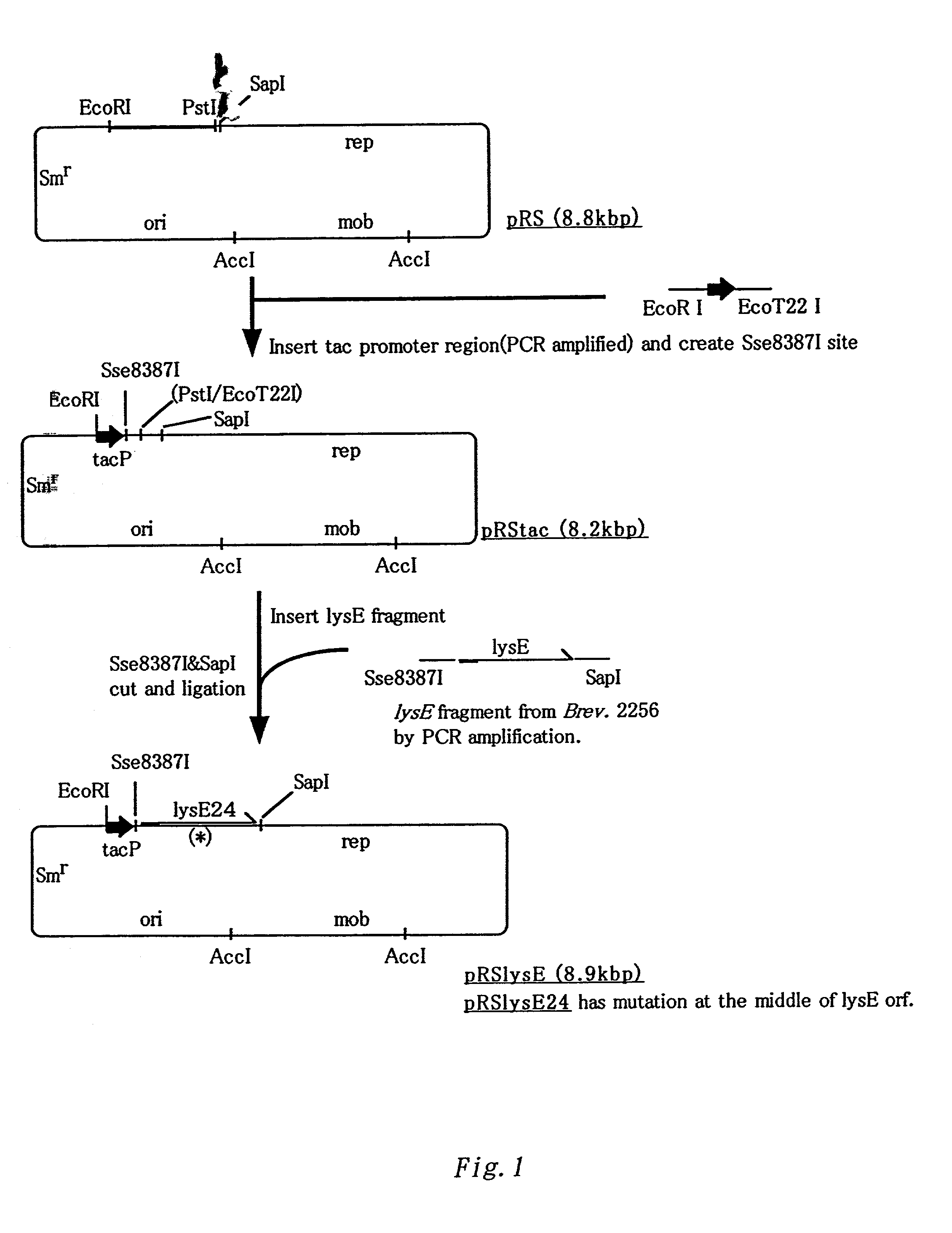Method for producing L-lysine or L-arginine by using methanol assimilating bacterium
a technology of lysine or arginine and methanol, which is applied in the field of microbial industry, can solve the problems of difficult to obtain the expression of a membrane protein of heterogeneous origin, the lyse cannot function, etc., and achieve the effect of efficient production of lysine or l-arginine and low cos
- Summary
- Abstract
- Description
- Claims
- Application Information
AI Technical Summary
Benefits of technology
Problems solved by technology
Method used
Image
Examples
example 1
Introduction of lysE Gene Derived from Brevibacterium bacterium into Methylophilus bacterium
[0074]An lysE gene, which was a homologous gene of the gene facilitating excretion of L-lysine known for Corynebacterium bacteria, was cloned from a Brevibacterium bacterium, and it was attempted to express it in a Methylophilus bacterium.
(1) Construction of pRSlysE
[0075]In order to introduce lysE into a Methylophilus bacterium, a known plasmid pRS (refer to International Patent Publication in Japanese (Kohyo) No. 3-501682) was used to construct a plasmid pRSlysE for expression of lysE. pRS is a plasmid having the vector segment of the pVIC40 plasmid (International Patent Publication WO90 / 04636, International Patent Publication in Japanese No. 3-501682) and obtained from pVIC40 by deleting a DNA region encoding the threonine operon contained in the plasmid. The plasmid pVIC40 is derived from a broad host spectrum vector plasmid pAYC32 (Chistorerdov, A. Y., Tsygankov, Y. D., Plasmid, 1986, 16...
example 2
Introduction of L-lysine Biosynthesis System Enzyme Gene and lysE24 Gene into Methylophilus methylotrophus
[0094]It was found that, when the lysE24 gene was introduced into Methylophilus methylotrophus AS1 strain, L-lysine was accumulated in the medium. It was considered that this was caused by enhancement of the excretion of L-lysine.
[0095]The inventors of the present invention had clarified that, if an L-lysine biosynthesis gene had been enhanced by a plasmid in a Methylophilus bacterium, a marked amount of L-lysine had been accumulated in a medium (Japanese Patent Application No. 11-368097). Therefore, there was investigated an effect of introduction of the lysE24 gene into Methylophilus methylotrophus of which L-lysine biosynthesis gene was enhanced.
Construction of Plasmid pRSdapA Having dapA* Gene
[0096]There was prepared a plasmid having a gene encoding dihydrodipicolinate synthase that did not suffer feedback inhibition by L-lysine (dapA*) as an L-lysine biosynthesis system e...
PUM
| Property | Measurement | Unit |
|---|---|---|
| temperature | aaaaa | aaaaa |
| hydrophobic | aaaaa | aaaaa |
| concentrations | aaaaa | aaaaa |
Abstract
Description
Claims
Application Information
 Login to View More
Login to View More - R&D
- Intellectual Property
- Life Sciences
- Materials
- Tech Scout
- Unparalleled Data Quality
- Higher Quality Content
- 60% Fewer Hallucinations
Browse by: Latest US Patents, China's latest patents, Technical Efficacy Thesaurus, Application Domain, Technology Topic, Popular Technical Reports.
© 2025 PatSnap. All rights reserved.Legal|Privacy policy|Modern Slavery Act Transparency Statement|Sitemap|About US| Contact US: help@patsnap.com


